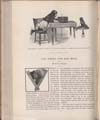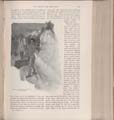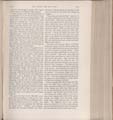
stnic.190406.001.001.jpg
Fun Among the Red Boys.
VARIOUS as are the customs of the the Indians, it is their savage, warlike natures that we are most apt to remember. Few of us, in fact, ever think of Indian children at all, except at the sight of a picture of them. Little has been told or written about the boy and girl red folk, and it would puzzle most of my readers to say what they suppose these children of nature look like, or do to amuse themselves, or how they are brought up. It will astonish most city people to hear that red children are very like white children, just as a lady who was out on the plains a few years ago was astonished to find that they had skins as smooth and soft as any lady's—no, smoother and softer than that: as delicate and lovely as any dear little baby's here in New York. This lady was visiting the Blackfeet in my company, and she was so surprised, when she happened to touch one little red boy's bare arm, that she went about pinching a dozen chubby-faced boys and girls to make herself sure that all their skins were like the coats of ripe peaches to the touch.
Whether the Indians really love their children, or know what genuine love or affection is, I cannot say; but they are so proud and careful of their little ones that it amounts to the same thing so far as the youngsters are concerned. Boy babies are always most highly prized, because they will grow up into warriors.
The little that is taught to Indian boys must seem to them much more like fun
than instruction. They must hear the fairy stories and

stnic.190406.001.002.jpg the gabble of the medicine-men or
conjurors,
and the tales of bloody fights and brave and
cunning deeds which
make the histories of their
tribes. They learn not to take what does not
belong to them unless it belongs to an enemy. [illustration - Onondaga Indian boys playing at "snow-snakes."] They learn not to be impudent to any one stronger and bigger than
themselves; they learn how to track animals and men, how to go without food when
there is not any, how to eat up all there is at once when
any food is to be had, how to ride and shoot and run and paddle, and smoke very
mild tobacco. As for the rest, they "just grow," like Topsy, and are as
emotional
and fanciful and wilful as any very little white
child ever was.
They never get over being so.
The older they grow to be, the older children
they become, for they are all very much like
spoiled children as long as they
live.
The first Indians I ever saw, outside of a show, were boys at play. They were
Onondagas, on their reservation near Syracuse, New York. They were big boys of
from sixteen to twenty years old, and the game they were playing was
"snow-snakes." The earth was covered with snow, and by dragging a stout log
through this covering they had made a narrow gutter or trough about 500 or 700
feet long. Each youth had his snow-snake, which is a stick about eight feet
long, and shaped something like a spear. All the snow-snakes were alike, less
than an inch wide, half an inch thick, flat on the under side, rounded on top,
and
with a very slight turn
upward at the point to
suggest a serpent's
head.
The "snakes "
were all smoothed and
of heavy hard wood.
The game was to see
who could send his the farthest along the gutter
in the snow. The young men
grasped their
snakes at the very end, ran a few steps, and
shot the sticks
along the trough. As one after
another sped along the snow, the serpent-like
heads kept bobbing up and down over the
rough surface of the gutter precisely
like so

stnic.190406.001.003.jpg many snakes. I bought a
snow-snake, but, though I have tried again and again, I cannot get the knack of
throwing it.
But I have since seen Indian boys of many tribes at play, and one time I saw more than a hundred and fifty "let loose," as our own children are in a country school-yard at recess. To be sure, theirs is a perpetual recess, and they were at home among the tents of their people, the Canada Blackfeet, on the plains, within sight of the Rocky Mountains. The smoke-browned tepees, crowned with projecting pole-ends, and painted with figures of animals and with gaudy patterns, were set around in a great circle, and the children were playing in the open, grassy space in the center. Their fathers and mothers were as wild as any Indians, except one or two tribes, on the continent, but nothing of their savage natures showed in these merry, lively, laughing, bright-faced little ragamuffins. At their play they laughed and screamed and hallooed. Some were running foot races, some were wrestling, some were on the backs of scampering ponies; for they are sometimes put on horseback when they are no more than three years old. Such were their sports, for Indian boys play games to make them sure of aim, certain of foot, quick in motion, and supple in body, so that they can shoot and fight and ride and hunt and run well. To be able to run fast is a necessary accomplishment for an Indian. What they call "runners" are important men in every tribe. They are the messenger [illustration - "You should have seen the stampede that followed the signal, 'go!'"] men, and many a one among them has run I hundred miles in a day. They cultivate running by means of foot races. In war they agree with the poet who sang:

stnic.190406.001.004.jpg could run fast enough to escape their captors and the spears and bullets of their pursuers.
A very popular game that attracted most of the Blackfeet boys was the throwing of darts, or little white hand-arrows, along the grass. The game was to see who could throw his arrow farthest in a straight line. At times the air was full of the white missiles where the boys were playing, and they fell like rain upon the grass.
In another part of the field were some larger boys with rude bows with which to shoot these same darts. These boys were playing a favorite Blackfeet game. Each one had a disk or solid wheel of sheet-iron or lead, and the game was to see who could roll his disk the farthest, while all the others shot at it to tip it over and bring it to a stop. The boys made splendid shots at the swift-moving little wheels, and from greater distances than you would imagine.
They play with arrows so frequently that it is no wonder they are good marksmen; yet you would be surprised to see how frequently they bring down the birds, rabbits, and gophers which abound on the plains. The houses of these plump little drab-colored creatures are holes in the turf, and as you ride along the plains you will see them everywhere around, hitting up on their haunches with their tiny fore paws held idle and limp before them, and their bead-like, bright eyes looking at you most trustingly— until you come just so near, when pop! suddenly down goes little Mr. Gopher in his hole. You may be sure the Indian boys find great sport in shooting at these comical little creatures. But the boys take a mean advantage of the fact that the restless gophers cannot stay still in one place any great length of time. When one pops into a hole it is only for a minute, and during that minute the Indian boy softly and deftly arranges a snare around the hole, so that when the gopher pops up again the snare can be jerked and the animal captured.
We gave the boys in the Blackfeet camp great sport by standing at a distance of a hundred yards from all of them and offering a silver quarter to whichever boy got to us first. You should have seen the stampede that followed the signal, "Go!" Blankets were dropped, moccasins fell off, boys stumbled and others fell atop of them, their black locks flew in the breeze, and the air was noisy with yelling and laughter.
These boys spin tops, but their "top-time" is the winter, when snow is on the ground and is crusted hard. Their tops are made of lead or some other metal, and are mere little circular plates which they cover with red flannel and ornament with tiny knots or wisps of cord all around the edges. These are spun with whips and look very pretty on the icy white playgrounds. Nearly all Indian boys play ball, but not as we do, for their only idea of the game is the girlish one of pitching and catching. All their games are the simplest, and lack the rules which we lay down to make our sports difficult and exciting.
The boys of the Papago tribe in the Southwest have a game which the fellows in Harvard and Yale would form rules about, if they played it, until it became very lively indeed. These Indian boys make dumb-bells of woven buckskin or rawhide. They weave them tight and stiff, and then soak them in a sort of red mud which sticks like paint. They dry them, and then the queer toys are ready for use. To play the game they mark off goals, one for each band or "side" of players. The object of each side is to send its dumb-bells over to the goal of the enemy. The dumb-bells are tossed with sticks that are thrust under them as they lie on the ground. The perverse things will not go straight or far, and a rod is a pretty good throw for one. The sport quickly grows exciting, and the players are soon battling in a heap, almost as if they were playing at football.
These are games that will not wear out while there are Indian boys to play them. On the oldest reservations, where even the grandfathers of the Indians now alive were shut up and fed by their government, the boys still play the old games. But wherever one travels to-day, even among the wildest tribes, a new era is seen to have begun as the result of the Indian schools, and Indian boys are being taught things more useful than any they ever knew before. The brightest boys in the various tribes are selected to be sent to these schools, and it is hoped that what they learn will make all the others anxious to imitate white men's ways.